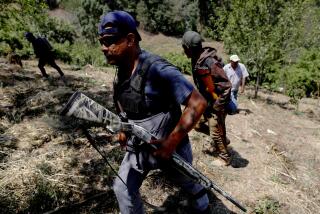A trip to Mexico’s Museum of Drugs
- Share via
Reporting from Mexico City — Army Capt. Claudio Montane wants one thing clear from the start: This place is not not a narco-museum. The point is not to glorify drug traffickers.
“Its purpose is to show Mexico and the world the efforts and the good results that we have achieved,” Montane said, opening a tour of a military collection officially called the Museum of Drugs.
But spend a couple of hours examining the exhibits with Montane, in his crisp dress uniform and spit-shined shoes, and you wonder if a better name would be the Museum of Mexico’s Long and Unwon War Against Drug Traffickers Who Keep Finding Clever New Ways to Feed the U.S. Habit.
Just as the museum outlines the army’s 33-year-old role in this war, it offers powerful testimony to the inventiveness and enormous resources that traffickers continue bringing to the fight.
FOR THE RECORD:
Museum of Drugs: An article in Monday’s Section A about Mexico’s Museum of Drugs referred to the museum as telling a tale of a cat-and-mouse battle with prehistoric roots. It should have said pre-Hispanic. —
From their use of semi-submersibles to sneak Colombian cocaine in by sea to powerful rifles capable of punching through armor, the smuggling gangs present a foe that can seem more formidable with every passing day.
A section full of captured cross-border smuggling artifacts -- including an innocent-looking doughnut and empanada that proved to be filled with drugs -- is a credit to on-the-ball soldiers in the field. But it prompts a nagging question: How much got through?
“Drug dealers are ingenious,” said Montane, who before running the museum was on the front line of the drug war, in the northern state of Sonora. “But the genius of the military people is more.”
This is no ordinary museum. For one, it’s closed to the public. Housed on the seventh floor of the Mexican Defense Ministry building here, it is instead used to teach military personnel about the drug trade they have been called upon to fight.
The collection was created in 1985, back when troops were mainly used to eradicate crops of marijuana and poppies by uprooting and burning them.
But the exhibits have never been more relevant than today, with the military playing a larger role in the drug war than at any time in its history. Mexican President Felipe Calderon has dispatched 45,000 troops across the country since declaring war on the drug cartels in December 2006.
It has been a bloody chapter. Clashes between troops and drug traffickers, and among rival gangs, have claimed more than 10,000 lives. A plaque at the museum’s entrance tallies the military’s losses since December 2006: 99 officers and soldiers have died.
The museum tells the story of a cat-and-mouse battle, with prehistoric roots. Mexico’s peoples used peyote and hallucinogenic mushrooms for rituals. Later, Spanish sailors showed up with marijuana seeds and Chinese traders brought poppy to Mexico’s Pacific region.
Subsequent exhibits depict the global campaign to stop illegal substances. In one telling map, arrows showing the routes of various illicit drugs converge on the United States.
There are exhibits showing clandestine heroin labs built from seized jugs and hoses, models of military helicopters zooming over eradication operations, and photographs illustrating how years of practice helped drug growers tease bigger yields from marijuana and poppy fields by the 1980s, when the drug trade became big business here.
In one room, a life-sized model of a farmer stands guard with a shotgun in a primitive drug encampment equipped with a police radio and bust of Jesus Malverde, the mustachioed patron saint of drug traffickers.
A nearby case holds poorly spelled bribe offers and threats. “I am very close,” warned one sign, scrawled on cardboard. “You are surrounded. If you cut the plant, you won’t leave here alive.”
But it is the “narco-culture” room that probably would be the crowd favorite, if crowds were allowed here. This is where the over-the-top trappings of the narco life are on display: bejeweled cellphones; engraved, gold-plated pistols; jackets with hideaway armor plating.
The exhibit reveals “the ostentation they use to impress their rival groups and the authorities,” Montane said.
Certain to impress is a gold-plated Colt .38 Super, studded with tiny red and green stones and engraved on the pistol grip with the date of Mexico’s independence: Sept. 16, 1810. (Who says bloodthirsty gangsters can’t be patriots?)
Another .38-caliber pistol, seized last year when authorities captured suspected drug lord Alfredo Beltran Leyva, is adorned with emeralds, an engraving of revolutionary leader Francisco “Pancho” Villa and a proverb: “I’d rather die on my feet than live on my knees.” (Who says bloodthirsty gangsters can’t be cliched?)
The allure of the narco existence, its spread into mainstream Mexican culture and the way it is passed like a garish keepsake from one generation to another worries Montane -- and many officials.
On the wall near the museum’s exit is a picture that Montane said was seized during a raid on a trafficker’s house. It shows a chubby boy, about a year old, sitting on the floor. He is clad in camouflage.
Around him, lined up like favored stuffed animals, are two dozen AK-47s.
More to Read
Sign up for Essential California
The most important California stories and recommendations in your inbox every morning.
You may occasionally receive promotional content from the Los Angeles Times.










